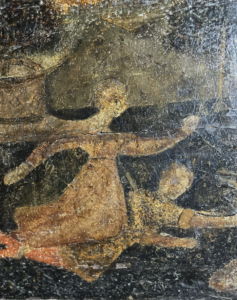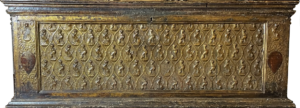Object of the Month: May 2023
Cassone
Walnut and pastiglia
Italian, 15th century
The antique furnishings in the Museum & Gallery collection elevate each visitor’s experience of the artwork on the walls, but the pieces also provide a historical context of the eras and cultures from which the artworks sprang. Indeed, the furnishings are also artworks in themselves.
This is certainly true of the many cassoni (plural of the Italian term for “chests”) in the collection. Like other furnishings in Renaissance homes, the quality of workmanship and materials employed in decorating each cassone convey a great deal about the fashion of their times, the technologies available to craftsmen, and the wealth and social status of their owners.
Unfortunately, much has gone against their survival to our day. Cassoni were used for storage of personal items, opened and closed numerous times over the years. That wear, along with the environment in a home, infestations of termites, dry rot, changes in taste and reversals of family fortunes all conspire against the preservation of these furnishings.
These rich, showy Italian types of chests became widespread in Northern and Central Italy, particularly Tuscany (with a number of the best artists hailing from the cities of Siena and Florence). Weddings served as the occasions for which cassoni were made, and they were in fashion from the 14th-16th centuries, a period spanning the very late-Middle Ages to the beginning and middle of the Renaissance. The oldest surviving cassoni feature primitive panel designs, while later works demonstrate lavish carving, gilding, polychrome, and more complex narrative scenes.
Much like moving trucks, boxes, and barrels accompanying the establishment of new homes, cassoni had a very specific use. Practically speaking, the chests were designed to contain the bride’s dowry and jewels, her family’s contribution to the marriage, and became one of the couple’s most important household furnishings—often at the foot of the bed. They quite literally became a vehicle displaying the status, wealth and sophistication of the intermarrying families, carried in a procession (the domum ductio) from the bride’s parent’s home to her groom’s abode.
Decoratively speaking, cassoni often feature heraldic imagery relating to the families’ crests, and the pictorial panels often contained biblical, mythological, or allegorical imagery which ranged from learned and literary to humorous and light-hearted. Cassoni themselves were so common in the early- and middle-Renaissance that they’re included in Old Master paintings (most familiar may be scenes of the Annunciation in which Mary is seated on or kneeling near a cassone situated at the foot of her curtained bed) and even picture-within-picture vignettes on cassoni panels themselves.
This particular M&G cassone entered the collection in 1957, and its features suggest a date very early after 1400, likely from Tuscany. Unlike many cassoni today, which have the panels removed and presented as separate works of art in their own right, our chest is in good original condition and is structurally sound, despite surviving 600 years of use and change. The lid is still attached with its original hinges and has a simple locking mechanism. While the lid opens and closes easily, the tight fit and years of use have worn off some of the gesso along the top edge.
Composed of thick walnut planks and framing, the chest has a large front center panel decorated with gilt and polychrome over trellis-embossed gesso. Heraldic lions (possibly leopards or even hunting dogs) face each other across the front, and the two vertical end panels blossom with delicate arabesques and outline colored shields, which likely contained familial coats of arms.
 Carved, fluted pilasters frame the two pictorial end panels and are topped with vague Corinthian capitals. The primitive-style narrative at the right end is now entirely obscured, but the imagery at the opposite end remains. The subject matter is indistinct and may be biblical or mythological. Most likely, perhaps, it is the myth of Diana (Artemis) and Actaeon, from Ovid’s Metamorphoses, in which the bathing goddess is startled by a young hunter. In her anger, Diana turns Actaeon into a stag who is then hunted and killed by his own hounds. This identification seems to make sense of the simplistic representation of forest, pool, a stag’s head (lower right) and a hound in the left background. As an allegory or fable for a young couple, it may emphasize modesty, self control, and consequences for the lack of either or both.
Carved, fluted pilasters frame the two pictorial end panels and are topped with vague Corinthian capitals. The primitive-style narrative at the right end is now entirely obscured, but the imagery at the opposite end remains. The subject matter is indistinct and may be biblical or mythological. Most likely, perhaps, it is the myth of Diana (Artemis) and Actaeon, from Ovid’s Metamorphoses, in which the bathing goddess is startled by a young hunter. In her anger, Diana turns Actaeon into a stag who is then hunted and killed by his own hounds. This identification seems to make sense of the simplistic representation of forest, pool, a stag’s head (lower right) and a hound in the left background. As an allegory or fable for a young couple, it may emphasize modesty, self control, and consequences for the lack of either or both.
This cassone provides insight into the artistry, fashion, and domestic life of those living in the early years of the Italian Renaissance and is a valuable part of the M&G collection.
Dr. Stephen B. Jones, M&G volunteer
Additional Resources:
The Oxford History of Western Art. Kemp, Martin, ed. Oxford University Press, 2000.
Pooley, Eugene. “Scenes from a Marriage.”
https://blog.dorotheum.com/en/classic-week-florentine-school/
https://www.medieval.eu/bridal-chests-or-cassoni-from-medieval-italy/
Published 2023
